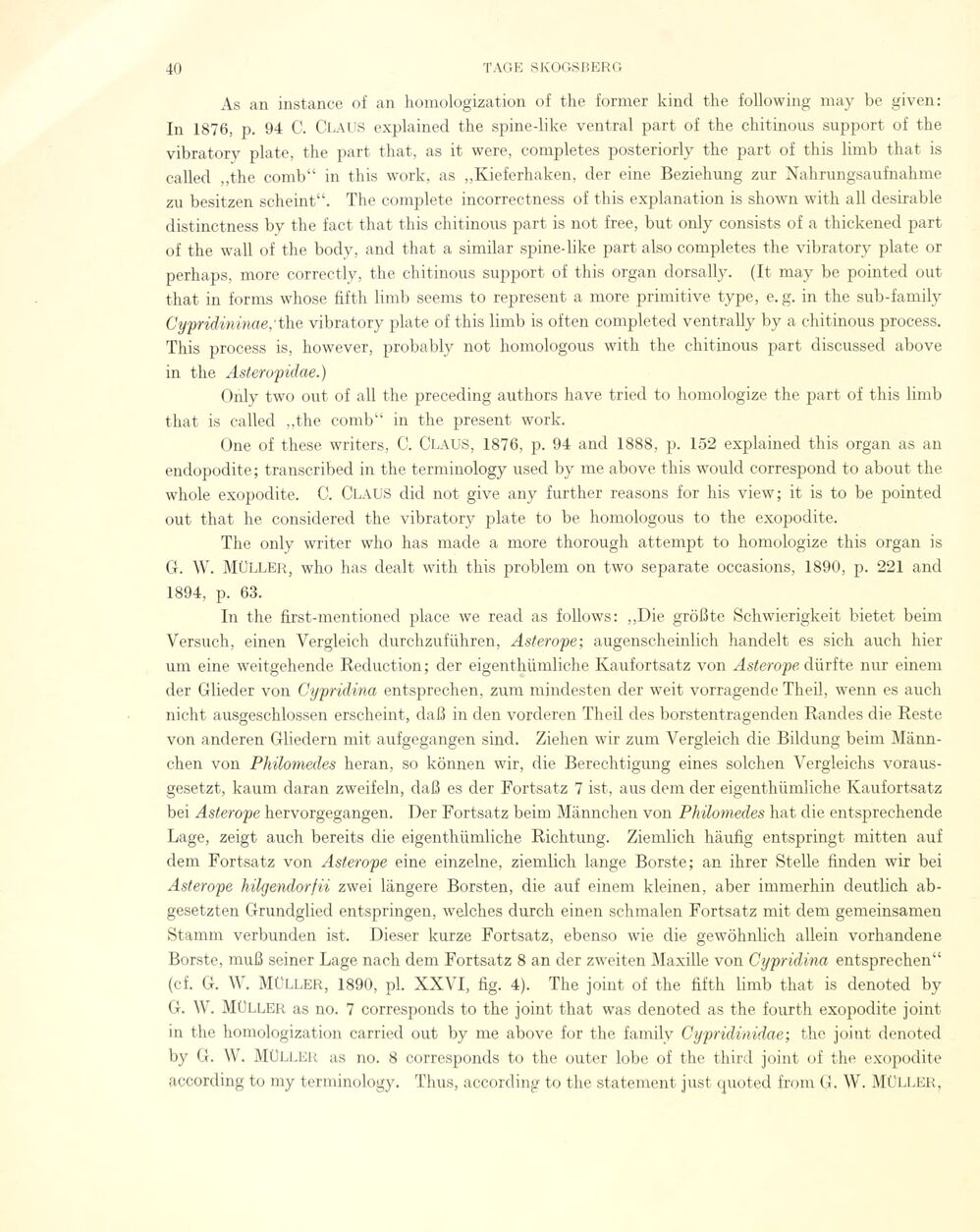
Full resolution (JPEG) - On this page / på denna sida - Sidor ...

<< prev. page << föreg. sida << >> nästa sida >> next page >>
Below is the raw OCR text
from the above scanned image.
Do you see an error? Proofread the page now!
Här nedan syns maskintolkade texten från faksimilbilden ovan.
Ser du något fel? Korrekturläs sidan nu!
This page has never been proofread. / Denna sida har aldrig korrekturlästs.
As an instance of an homologization of the former kind the following may be given:
In 1876, p. 94 C. CLAUS explained the spine-like ventral part of the chitinous support of the
vibratorv plate, the part that, as it were, complétés posteriorly the part of this limb that is
called „the comb“ in this work, as „Kieferhaken, der eine Beziehung zur Nahrungsaufnahme
zu besitzen scheint“. The complete incorrectness of this explanation is shown witli all desirable
distinctness by the faet that this chitinous part is not free, but only consists of a thickened part
of the wall of the bodv, and that a similar spine-like part also complétés the vibratory plate or
perhaps, more correctly, the chitinous support of this organ dorsally. (It may be pointed out
that in forms whose fit’th limb seems to represent a more primitive type, e. g. in the sub-family
Cypridininae;the vibratory plate of this limb is often completed ventrally by a chitinous process.
This process is, however, probably not homologous with the chitinous part discussed above
in the Asteropidae.)
Only two out of all the preceding authors have tried to homologize the part of this limb
that is called „the comb“ in the present work.
One of these writers, C. CLAUS, 1876, p. 94 and 1888, p. 152 explained this organ as an
endopodite; transcribed in the terminology used by me above this would correspond to about the
whole exopodite. C. CLAUS did not give any further reasons for his view; it is to be pointed
out that he considered the vibratory plate to be homologous to the exopodite.
The only writer who has made a more thorough attempt to homologize this organ is
G. W. MÜLLER, who has dealt with this problem on two separate occasions, 1890, p. 221 and
1894, p. 63.
In the first-mentioned place we read as follows: „Die größte Schwierigkeit bietet beim
Versuch, einen Vergleich durchzuführen, Asterope; augenscheinlich handelt es sich auch hier
um eine weitgehende Réduction; der eigenthümliche Kaufortsatz von Asterope dürfte nur einem
der Glieder von Cypridina entsprechen, zum mindesten der weit vorragende Theil, wenn es auch
nicht ausgeschlossen erscheint, daß in den vorderen Theil des borstentragenden Randes die Reste
von anderen Gliedern mit aufgegangen sind. Ziehen wir- zum Vergleich die Bildung beim
Männchen von Philomedes heran, so können wir, die Berechtigung eines solchen Vergleichs
vorausgesetzt, kaum daran zweifeln, daß es der Fortsatz 7 ist, aus dem der eigenthümliche Kaufortsatz
bei Asterope hervorgegangen. Der Fortsatz beim Männchen von Philomedes hat die entsprechende
Lage, zeigt auch bereits die eigenthümliche Richtung. Ziemlich häufig entspringt mitten auf
dem Fortsatz von Asterope eine einzelne, ziemlich lange Borste; an ihrer Stelle finden wir bei
Asterope hilgendorfii zwei längere Borsten, die auf einem kleinen, aber immerhin deutlich
abgesetzten Grundglied entspringen, welches durch einen schmalen Fortsatz mit dem gemeinsamen
Stamm verbunden ist. Dieser kurze Fortsatz, ebenso wie die gewöhnlich allein vorhandene
Borste, muß seiner Lage nach dem Fortsatz 8 an der zweiten Maxille von Cypridina entsprechen“
(cf. G. W. Müller, 1890, pl. XXVI, fig. 4). The joint of the fifth limb that is denoted by
G. W. MÜLLER as no. 7 corresponds to the joint that was denoted as the fourth exopodite joint
in the homologization carried out by me above for the familv Cypridinidae; the joint denoted
by G. W. MÜLLER as no. 8 corresponds to the outer lobe of the tliird joint of the exopodite
according to my terminology. Thus, according to the statement just quoted from G. W. MÜLLER,
<< prev. page << föreg. sida << >> nästa sida >> next page >>